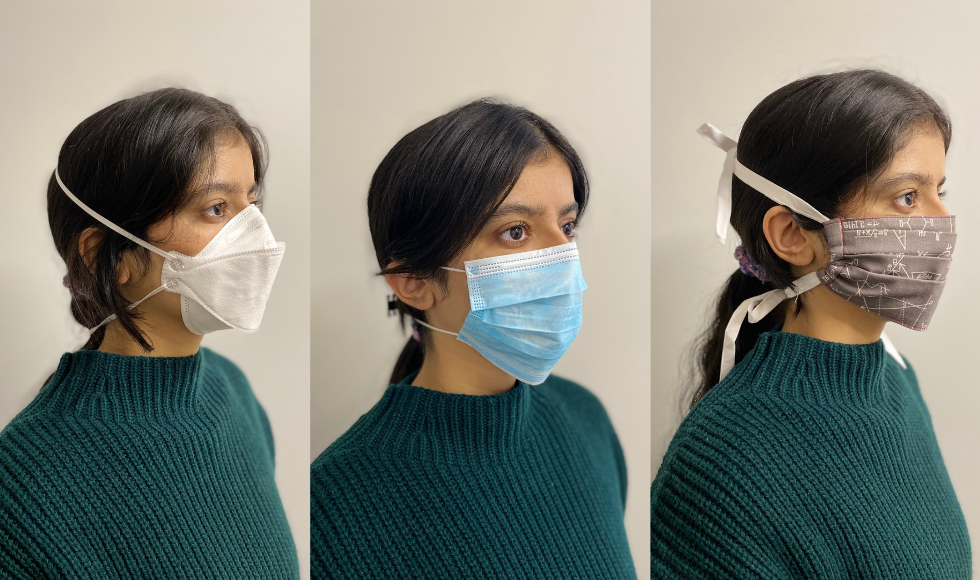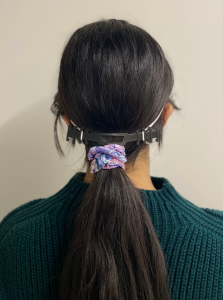Ask a McMaster Expert: Guidance on masking quality and fit

As more students, staff and faculty return to in-person activities, we’ve heard your questions around mask effectiveness and guidance for selecting a mask to wear on campus.
We spoke with Ravi Selvaganapathy, professor of mechanical engineering and director of McMaster’s Centre of Excellence in Protective Equipment and Materials (CEPEM), and Catherine Clase, professor of medicine and member of CEPEM, to answer your questions around what makes a good quality mask, the importance of fit and current Public Health guidelines for masking.
In this guide:
- Selecting a mask
- Comparing mask types (N95s, surgical and cloth masks)
- Wearing a mask
- Reusing your mask
SELECTING A MASK
What makes a good mask?
Selvaganapathy: A good mask should have sufficient filtration capability, should be easy to breathe through and should fit close to the person’s face. Different types of masks are appropriate for different settings, situations, and personal preference. While an N95 is appropriate for some hospital settings, which are higher risk, a triple layer cloth mask, can be an effective option for areas such as the grocery store.
How can you tell if a mask is good quality?
Selvaganapathy: There are standards available for surgical masks and N95 designation provided by NIOSH and ASTM, respectively. In Canada we have the CAN95 standard, equivalent to N95, and trustworthy. The designation imprinted on the mask demonstrates that it meets high-quality standards. ASTM has recently come up with voluntary standards for masks for the public (F3502). We hope that these will catch on with manufacturers and these will also signify masks which meet a quality criterion suitable for public use.
What are the best materials for making a mask that best filters out aerosol-sized particles?
Clase: Meltblown polypropylene is the best filter – it is found in the middle layer of certified masks as well as N95s and CAN95s. It’s a fine delicate structure and not washable. Spunbond polypropylene is found in the outer layers of certified masks and is widely available in retail (there’s a list of suppliers on our website). It’s not as good of a filter as meltblown, but it’s washable, and is recommended by the World Health Organization and Health Canada as a middle layer for masks.
How effective are the masks the university distributed in the fall?
Selvaganapathy: The masks distributed by the university were made with a spun bound inner layer and continue to be suitable for general use according to provincial guidance.
COMPARING MASK TYPES
How do surgical and cloth masks compare to N95s?
Selvaganapathy: Both surgical masks and N95s are capable of filtering sub-micron particles to greater than 95% efficiency. Surgical masks have better breathability than N95 but need to be sized and fitted properly to get a good fit.
Clase: Cloth masks come in a wide range of filtration efficiencies. Some have a spunbond filter material inserted in between cloth layers and offer comparable filtration properties as the surgical masks. While others that are just made of cloth may not have as high a filtration property. The cloth masks with spunbond inserts are suitable for most public use. Pay close attention to fit when putting on mask, checking with your hands to feel for leaks, seeing if you can fog up your glasses, and performing a user seal test as shown in this video.
What kind of cloth mask is the most effective?
Clase: Look for multiple layers – at least three. We know that cotton is a good choice – but don’t have data to say that it is better than other materials. There are other good things about cotton – it is usually comfortable, it has wicking properties for moisture from breath, and it expands when damp, which improves filtration. Look for overhead ties or adjustable earloops and once you are wearing it, check for gaps at the sides, under the chin, and under the eyes. A nosewire may improve fit under the eyes; take time to adjust this to minimize gaps.
WEARING A MASK

How important is fit? How can you ensure that a mask fits properly?
Selvaganapathy: The mask fit is critically important. We can take a good quality mask such as the surgical masks and by not ensuring a good fit with the face of the wearer create gaps through which majority of the air will flow and significantly increase the number of particles that could be breathed in. For N95 a fit testing is typically done to ensure the right design and size of the mask is being used for that particular individual. For surgical masks also, choosing the right size, or adapting it to fit (see below), and ensuring that the fit at the nose region is ensured by adjusting the nose clip appropriately is important.
What are ‘Mask Hacks’ and how can they help improve overall surgical mask filtration?
Clase: Modifications to the way we wear masks to improve their overall filtration are often called ‘mask hacks’. For example, if you are wearing a surgical mask, consider putting the bottom of the ear loops on an ear guard at the nape of your neck (you can make one from an elastic band and two paperclips) or attaching the ear loops to buttons on a headband.
Mask braces which seal the edge of the mask also work, but they must be made or purchased and are less comfortable. Best and simplest of all is to wear a good-fitting cloth mask over a surgical mask. You can watch a video on how to do this below.
What about double masking? Does this improve mask filtration?
Clase: Double masking is wearing a well-fitted cloth mask over a surgical mask. The fit of the cloth mask, rather than the filtration of its material, is important in this setting. In peer-reviewed experiments using a cloth over mask with filtration improved how effective the mask is.
REUSING YOUR MASK:
How many times can I reuse a disposable mask, N95 or CAN95?
Clase: The filtration property of the material, including the charge that is applied to N95s and CaN95s, should not deteriorate with wear. For community use, masks or N95/CaN95s should be dried between uses and discarded if soiled externally or soiled with mucus inside.
How do I wash my cloth mask?
Clase: Masks made of 100% cotton can be hot washed and tumble dried. Tumble drying may affect the filtration properties of spunbond polypropylene, so we recommend that these be hot washed and hung to dry.
Back to Mac Updates, Faculty and staff, Health, Students, Uncategorized
